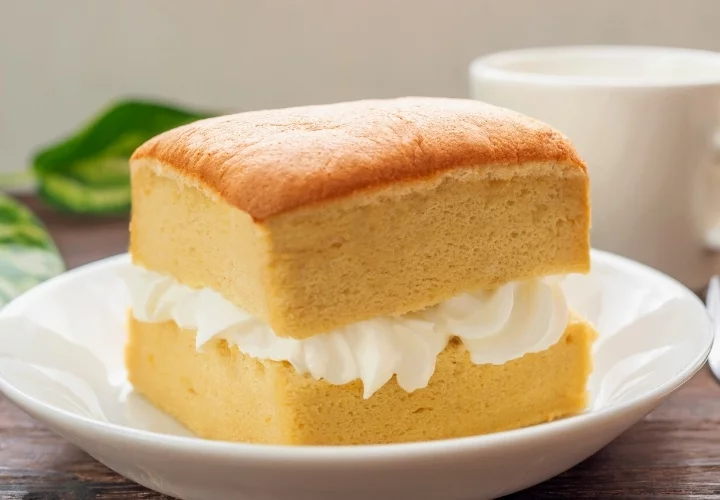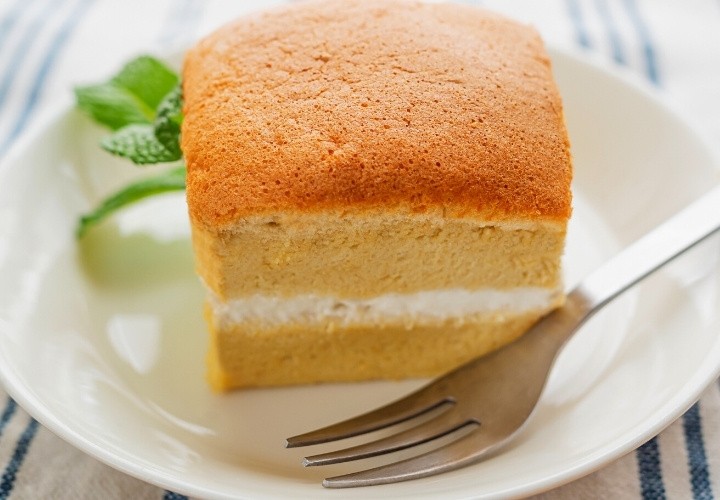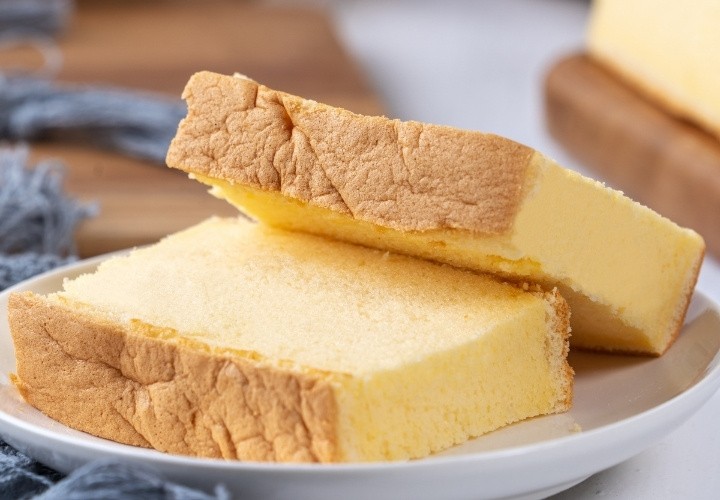The famous sponge cake known as Taiwanese castella cake often referred to as Taiwanese soufflé castella, is renowned for its soft, fluffy texture and distinctive bounce. It is wonderful on its own or when topped with whipped cream and fruits. It is delicately sweetened.
Taiwanese castella cake may be found in various bakeries and street vendors there. Watching a large pan of jiggly sponge cake being turned out and sliced into rectangles is fascinating!
Some merchants would even prepare whipped cream filling for the cakes or use cheese to produce savory ones. They all seem fantastic! We’re thrilled to offer this incredibly jiggly and pillow-soft castella cake recipe to you now that it has been through several tests.
So, What is Taiwanese Souffle Castella Cake?
A jiggly cake baked in a water bath is the basic component of Taiwanese castella cake or Taiwanese soufflé castella. It has a caramelized top, is really fluffy and soft, and when you cut or tear a piece of it, it produces that lovely “u wo” sound.
From bakeries to cafés serving street food, it gained popularity in Taiwan. In such bakeries and cafés, you would frequently see Taiwanese castella cake made on a meter-long pan and cut into sizable rectangles.
Typically, these cakes are prepared in big 1-meter slabs that are immediately cut into large rectangles and placed in boxes for the many consumers who are lined up outside the businesses to pick up. There are nearly always lineups outside the stores since these cakes are so desirable.
Japanese castella cake vs Taiwanese castella cake
The original castella is a cake that was invented in Japan after being brought by the Portuguese, notwithstanding souffle castella’s popularity in Taiwan. Japanese castella is a classic confection with a darker crust that is produced using eggs, bread flour, sugar, and mizuame, a sort of sugar syrup that gives the cake a moist feel.
Japanese castella is cooked in a wooden rectangular or square mold, not on a massive scale like the Taiwanese variant, and is best eaten the day after baking since it has a moister feel.
Despite sharing the same name, each cake has its own distinctive charms. Because of its fluffy texture, I personally prefer the Taiwanese variety, but try this recipe and let me know what you think!
Castella Cake Recipe
Ok, after we’ve learned everything we need to know, it’s time to make this amazing Taiwanese castella cake. To get the best results with your cake, be sure to read the tips below the recipe card.
Ingredients
- Eggs: 10 large
- Cake Flour: 4.5 oz (130 grams)
- Unsalted Butter: ½ cup, melted (70 grams)
- Neutral Oil: ½ cup (70 ml)
- Whole Milk: 1 cup, room temperature (120 ml)
- Vanilla Extract: 3 tsp
- Granulated Sugar: 1 cup (120 grams)
- White Vinegar: 2 tsp (alternatively, lemon juice or cream of tartar)
Equipment
- 8 × 8 x 3-inch pan
- Baking sheet
- Large oven-safe tray or pan for water bath
- Two large mixing bowls
- Hand mixer
- Sifter
- Spatula
- Parchment paper
- Toothpick
Instructions
Step 1: Pre-heat and Prepare Tools
- Preheat Oven: Set your oven to 300°F (150°C).
- Prepare Pan: Line the 8 × 8 x 3-inch pan with parchment paper and place it on a baking sheet.
- Water Bath Setup: Have a larger oven-safe tray or pan ready for a water bath. Boil water in a kettle or a pot.
Step 2: Make the Batter Base
- Sift Flour: Sift the cake flour into a large mixing bowl to remove lumps.
- Combine Wet Ingredients: Gradually whisk in the neutral oil and melted butter until smooth.
- Add Milk: Stir in the whole milk until just incorporated.
- Egg Yolks & Vanilla: Separate the yolks from 10 eggs. Add the yolks and vanilla extract to the mixture, stirring gently.
Step 3: Making the Meringue
- Whip Egg Whites: In a second large bowl, combine egg whites and vinegar. Beat with a hand mixer at medium-high speed until foamy.
- Add Sugar: Gradually add granulated sugar while continuing to beat until fully incorporated.
- Reach Medium Peaks: Slow down the mixer, whipping until the meringue forms medium peaks (a peak with a slight curve at the tip when the beaters are lifted).
Step 4: Combine and Bake
- Fold in Meringue: Gently fold ⅓ of the meringue into the batter using a “J” shape motion with a spatula. Repeat twice more with the remaining meringue, ensuring even color and texture.
- Prepare for Baking: Pour the batter into the prepared pan. Tap the pan to release large air bubbles.
- Water Bath: Place the pan in the larger tray. Carefully pour boiling water into the tray, reaching halfway up the sides of the cake pan.
- Bake: Bake for 65-70 minutes. Check doneness with a toothpick – it should come out clean.
Step 5: Cut and Serve
- Cooling: Let the cake cool slightly before removing it from the pan.
- Serving: Cut into 8 equal slices. Serve warm for a jiggly texture or cool for a firmer, less eggy taste. Enhance with whipped cream and fruit if desired.
Enjoy your delicious Taiwanese Castella Cake!
Taiwanese castella cake FAQs
Why does my castella cake crack?
Taiwanese castella cake surface cracks can be brought about by overly whipped meringue, a hot oven, or baking inside a pan that is too small.
Why did my castella cake shrink in size?
As with all soufflé-type cakes, Taiwanese castella cake will somewhat shrink or deflate after being taken out of the oven. Ensure the meringue is whisked to a medium peak and the cake is thoroughly cooked to avoid the castella cake losing a lot of volume.
Why does the bottom of my castella cake have a dense layer?
Your Taiwanese castella probably have a dense layer at the bottom because the meringue was likely not well-whipped. Ensure the meringue is whipped to a medium peak.
Share the image below to your Pinterest board if you like this Taiwanese Castella Cake Recipe!
Castella Cake Tips
- Maintain the ingredients at room temperature or warm. To avoid the butter from hardening, it is better to maintain the remaining ingredients at room temp or slightly warmer.
- Choose a large square pan if feasible. Castella cake requires a square pan with tall edges for support while it bakes. Only when you do not have a 3-inch-deep square pan, you may support the castella cake with reusable paper.
- If you desire the surface of the Taiwanese castella cake to be darker, broil the cake. Adjust the oven’s broiler settings to high and brown the cake’s surface to your liking. However, make sure to maintain attention! The cake can get scorched in a matter of seconds!
Taiwanese castella cake frequent issues
Castella cake’s top has cracked
The meringue was far too solid. To medium peak, whisk the meringue. The cake is liable to split if it becomes any stiffer.
- The oven temperature was excessively high. Because each oven is unique, it is essential to use a thermometer to ascertain the temperature readings of your oven.
- The cooking pan was too shallow. If the pan is too shallow, the can will extend outward as it breaks and separates.
Deflating cake:
Even while Taiwanese castella cake will certainly deflate somewhat as it cools, it shouldn’t deflate significantly.
- Your meringue was probably too soft. Soft peak meringue provides a Taiwanese castella cake that is more jiggly but also encourages more pronounced shrinkage and deflation.
- The cake was not properly cooked. The cake will deflate, collapse, and compress as it cools if it is fully cooked. Stick a toothpick into the center of the cake to determine when it is done. There should be no or very few crumbs left behind.
- A cake with uneven crumbs and large bubbles:
- This concern is primarily aesthetic. Equally delicious will be the castella cake.
- The Meringue was beaten too quickly. After adding the sugar, the meringue should be beaten at a medium speed. This makes the finished batter smoother by aerating the meringue without creating big bubbles.
- Incorrect meringue inclusion. Use a gentle “J” folding motion to incorporate the meringue into the mixture. If you fold the batter forcefully, extra air might be introduced, resulting in a coarse, uneven crumb.
Nutrition
Serving: 1 piece
- Calories: 290kcal
- Carbohydrates: 24g
- Protein: 8.5g
- Fat: 18.6g
- Saturated Fat: 6.1g
- Monounsaturated Fat: 7g
- Polyunsaturated Fat: 2.9g
- Cholesterol: 200mg
- Potassium: 109mg
- Sodium: 78mg
- Sugar: 13.1g
- Calcium: 47mg
- Vitamin A: 469IU
- Iron: 1mg





